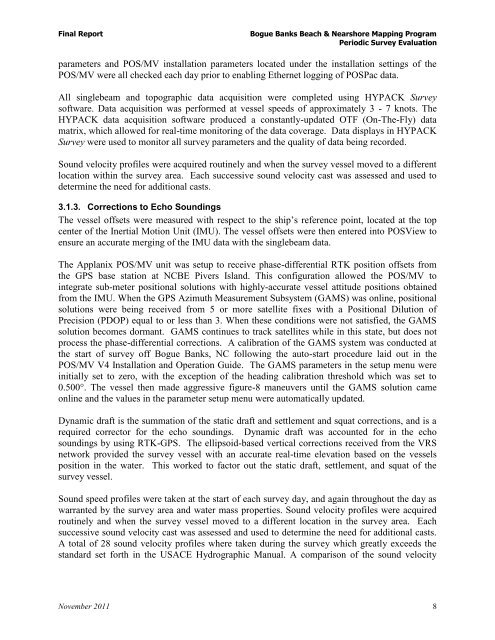Bogue Banks Beach - Carteret County Shore Protection Office
Bogue Banks Beach - Carteret County Shore Protection Office
Bogue Banks Beach - Carteret County Shore Protection Office
Create successful ePaper yourself
Turn your PDF publications into a flip-book with our unique Google optimized e-Paper software.
Final Report <strong>Bogue</strong> <strong>Banks</strong> <strong>Beach</strong> & Nearshore Mapping Program<br />
Periodic Survey Evaluation<br />
parameters and POS/MV installation parameters located under the installation settings of the<br />
POS/MV were all checked each day prior to enabling Ethernet logging of POSPac data.<br />
All singlebeam and topographic data acquisition were completed using HYPACK Survey<br />
software. Data acquisition was performed at vessel speeds of approximately 3 - 7 knots. The<br />
HYPACK data acquisition software produced a constantly-updated OTF (On-The-Fly) data<br />
matrix, which allowed for real-time monitoring of the data coverage. Data displays in HYPACK<br />
Survey were used to monitor all survey parameters and the quality of data being recorded.<br />
Sound velocity profiles were acquired routinely and when the survey vessel moved to a different<br />
location within the survey area. Each successive sound velocity cast was assessed and used to<br />
determine the need for additional casts.<br />
3.1.3. Corrections to Echo Soundings<br />
The vessel offsets were measured with respect to the ship’s reference point, located at the top<br />
center of the Inertial Motion Unit (IMU). The vessel offsets were then entered into POSView to<br />
ensure an accurate merging of the IMU data with the singlebeam data.<br />
The Applanix POS/MV unit was setup to receive phase-differential RTK position offsets from<br />
the GPS base station at NCBE Pivers Island. This configuration allowed the POS/MV to<br />
integrate sub-meter positional solutions with highly-accurate vessel attitude positions obtained<br />
from the IMU. When the GPS Azimuth Measurement Subsystem (GAMS) was online, positional<br />
solutions were being received from 5 or more satellite fixes with a Positional Dilution of<br />
Precision (PDOP) equal to or less than 3. When these conditions were not satisfied, the GAMS<br />
solution becomes dormant. GAMS continues to track satellites while in this state, but does not<br />
process the phase-differential corrections. A calibration of the GAMS system was conducted at<br />
the start of survey off <strong>Bogue</strong> <strong>Banks</strong>, NC following the auto-start procedure laid out in the<br />
POS/MV V4 Installation and Operation Guide. The GAMS parameters in the setup menu were<br />
initially set to zero, with the exception of the heading calibration threshold which was set to<br />
0.500°. The vessel then made aggressive figure-8 maneuvers until the GAMS solution came<br />
online and the values in the parameter setup menu were automatically updated.<br />
Dynamic draft is the summation of the static draft and settlement and squat corrections, and is a<br />
required corrector for the echo soundings. Dynamic draft was accounted for in the echo<br />
soundings by using RTK-GPS. The ellipsoid-based vertical corrections received from the VRS<br />
network provided the survey vessel with an accurate real-time elevation based on the vessels<br />
position in the water. This worked to factor out the static draft, settlement, and squat of the<br />
survey vessel.<br />
Sound speed profiles were taken at the start of each survey day, and again throughout the day as<br />
warranted by the survey area and water mass properties. Sound velocity profiles were acquired<br />
routinely and when the survey vessel moved to a different location in the survey area. Each<br />
successive sound velocity cast was assessed and used to determine the need for additional casts.<br />
A total of 28 sound velocity profiles where taken during the survey which greatly exceeds the<br />
standard set forth in the USACE Hydrographic Manual. A comparison of the sound velocity<br />
November 2011 8


